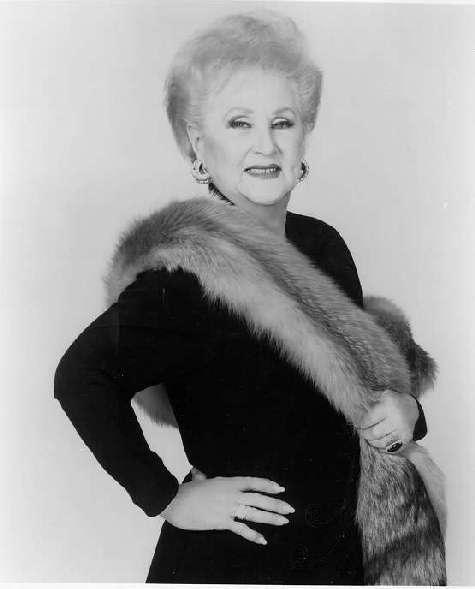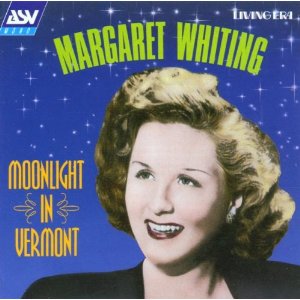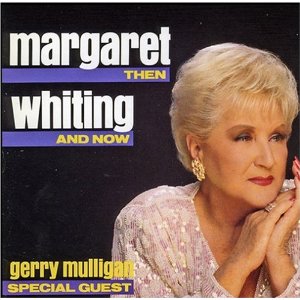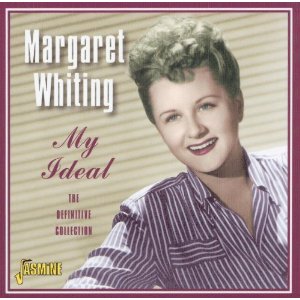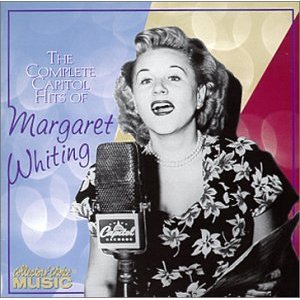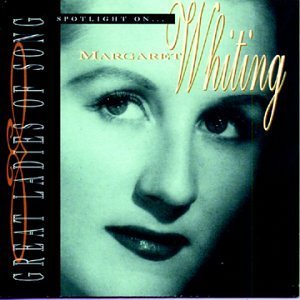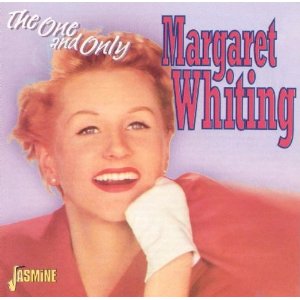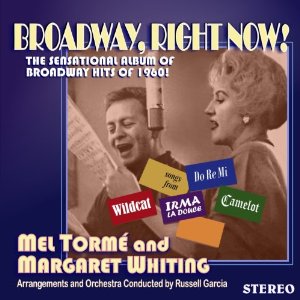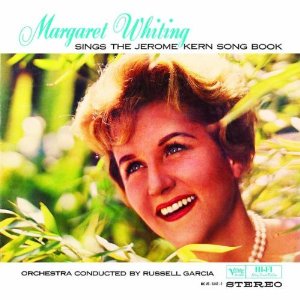Singing For The Starry-Eyed
A Personal Reflection On Margaret Whiting
By David McGee
Margaret Whiting, one of the great ladies of American song (and she would prefer the emphasis be on “ladies” rather than “great”), died on January 11 at the Lillian Booth Actors’ Home in Englewood, NJ, where she had moved this past March after living for years in a well appointed apartment on West 58th Street, a couple of doors west of the Plaza Hotel, in Manhattan. She was 86. Her daughter Deborah Whiting survives her.
Margaret Whiting, ‘It Might As Well Be Spring,’ an Academy Award winning song by Rodgers and Hammerstein for the 1945 film State Fair. Singing with the Paul Weston Orchestra, Ms. Whiting’s single version had a six-week run on the pop charts, peaking at #6.A contemporary of distaff pop vocal giants Jo Stafford, Peggy Lee and Rosemary Clooney, Whiting’s recordings of “Moonlight in Vermont,” “It Might As Well Be Spring,” “That Old Black Magic,” “Come Rain or Come Shine” and others sold in the millions in the ‘40s and ‘50s, at the height of her popularity. She traded in romance, as limned by some of the great pop songwriters in history, including her father, Richard Whiting, composer of standards such as “Beyond the Blue Horizon,” “Hooray for Hollywood” and “Too Marvelous For Words (he also wrote movie songs, including “The Good Ship Lollipop” for Shirley Temple, a tune inspired by his daughter’s sticky kisses after coming home from school with lollipop in hand), and especially those of her mentor and Whiting family friend—and sometime Richard Whiting collaborator—Johnny Mercer, who stepped in following Richard Whiting’s death to become a surrogate father to the then-13-year-old Margaret. And talk about being a product of your environment: owing to the respect with which her father was regarded as a songwriter, the Whiting home became a gathering place for the likes of George and Ira Gershwin, Jerome Kern, Harold Arlen, Frank Loesser and others, and young Margaret absorbed all she could of their interactions with her father.
Blessed with a sweet, warm, cornet-like voice, Ms. Whiting also possessed an abundance of the extra ingredient that makes songs meaningful beyond the quality of their writing and arranging. She defined this rare quality herself in a 2001 interview when asked to distinguish between a good singer and a great one.
“Being a great actress, being very dramatic,” she said. “Some people sing beautiful songs, but they don’t put all the meaning into them, and that’s the important thing. To read a lyric, to make the words come alive, that’s the secret.”
Margaret Whiting, ‘Alone Together.’ Written by Arthur Schwartz and Howard Dietz for the 1932 Broadway musical Flying Colors, the song was introduced in that production by Jean Sargent. Over time it found its way into the repertoires of several prominent jazz artists, including Miles Davis, Dizzy Gillespie, Art Blakey & the Jazz Messengers, the Kirk Lightsey Quartet, Jim Hall and Ron Carter (on their acclaimed 1972 album, Alone Together), Stanley Turrentine (with Gene Harris and the Three Sounds) and the Jessica Williams Trio. This uptempo, Latinized version by Margaret Whiting seems inspired by a similar, albeit mellower, take courtesy Joe Williams and Harry ‘Sweets’ Edison on their 1961 Together/Have a Good Time album.Born in Detroit on July 22, 1924, Margaret Whiting moved with her family to Los Angeles in 1929, when she was seven. In addition to her songwriter father, Margaret’s sister Barbara Whiting was an actress (she starred in the weekly radio series Junior Miss, based on the New Yorker stories of Sally Benson, and played the part of Fuffy Adams in the 1945 George Seaton-directed film version of Junior Miss; and portrayed the character of Ruth Williams in director Harry Horner’s 1954 thriller, Beware, My Lovely, starring Ida Lupino and Robert Ryan); her aunt, Margaret Young (her mother’s sister), was a singer and comedienne who recorded for Brunswick Records from 1922 through 1925, and again for Capitol Records (the Mercer connection) in 1949.
“I can't think of any other singer who grew up in a household where you would go into your father's studio and have someone like Arthur Schwartz working there,” she told Johnny Frank in an undated interview at Talkin’ Broadway. “Imagine growing up and hearing Harold Arlen playing piano and singing his songs. Johnny Mercer was my father's best friend and became mine as well. And Harold Arlen, whom I would call Uncle Harry, and Harry Warren: those were ones who I really became close to.
“It gave me some incredible opportunities. My best girlfriend in school was Harry Warren's daughter, Cookie, and I would often spend the weekend there. One night, Harry Warren told me that Glenn Miller was going to come to hear a song that Harry had written for him for a new picture. Cookie told me that she had a date for me that night so we all could go out, but I told her I was staying right at her house to meet Glenn Miller. I sat at the bar; Harry was wonderful about it. He introduced me as Dick Whiting's daughter and told Glenn that I was going to be a singer and wanted to meet him and hear the song. So Harry sat at the piano and Glenn ended up picking up his trumpet and playing along to the song, which was ‘Chattanooga Choo Choo!’ I got to be one of the first people to hear it! So that's really what was wonderful for me growing up, since I got to know so many of the songwriters who liked me and thought I had talent. They would then tell me how to read a lyric and sing a song, and challenge me to try and find a different end to a song.”
Margaret and Barbara Whiting in a brief clip from their sitcom, Those Whiting Girls, a summer replacement for I Love Lucy from 1955 to 1957.According to the singer, when she was seven years old her mother enlisted Mercer to listen to the young Margaret sing. Mercer’s reaction came in the form of two words of advice to the girl: “Grow up”—a suggestion he later amplified with “find a style that’s uniquely your own.”
“He meant that I wasn’t ready yet,” she told Talkin’ Broadway. “I had years of experience that I still needed to accumulate and go through. He would come over for a visit, sit me down and have me read the lyric to a song as if it were a poem, which is the way I teach people to sing as well. I have them talk the lyric out until it sounds like something they really believe, like an actor with a monologue.”
She took Mercer’s advice to heart so well that he made 18-year-old Margaret one of Capitol Records’ first signings upon the label’s founding in 1942 and oversaw her debut recording, “My Ideal,” a Richard Whiting song previously recorded by Frank Sinatra, among others. Her professional career kicked into high gear then, as she teamed with Mercer on a popular radio show and became a featured vocalist, live and on record, with the bands of Freddie Slack, Paul Weston and Billy Butterfield. Working with these bands between 1942 and 1945, she recorded five consecutive Top 20 singles: “That Old Black Magic” (1942, with Slack, #10); “My Ideal” (1943; with Butterfield, #12); “Silver Wings In The Moonlight” (1944, Slack, #19); “Moonlight in Vermont” (1945, Butterfield, #15) and “It Might As Well Be Spring” (1945, Weston, #6). She began her solo career after leaving Weston’s orchestra in 1945 and cut a solo hit out of the box, “All Through the Day” (#11) and thereafter was a regular presence in the Top 30 up to 1958; against all odds, in the rock ‘n’ roll era she returned to the upper reaches of the charts in 1966, with “The Wheel of Hurt.”
Margaret Whiting’s signature song, ‘Moonlight in Vermont’Of the songs she transformed into classics, the one most associated with Ms. Whiting, her “signature song,” as she called it, was the aching, romantic “Moonlight In Vermont,” written and published in 1943 by John Blackburn and Karl Suessdorf. Other memorable versions have followed Ms. Whiting’s—notably Jo Stafford’s lovely 1946 treatment, Frank Sinatra’s Nelson Riddle-arranged take in 1957 (on his Come Fly With Me album) and his stunning revisitation of it in a live set at New Jersey’s Meadowlands Arena in March 1986, released in 2009 on Live At The Meadowlands; even the newly deceased Captain Beefheart offered his own skewed homage to it on his celebrated Trout Mask Replica album—but the definitive version remains hers, in all its wistful, tender beauty.
Mercer found the song for her, and Ms. Whiting remembered having a devil of a time gaining a foothold in the lyric. After all, the sycamore trees and the Meadowlarks the songwriters so lovingly observed do not exist in Vermont.
"I was so busy trying to capture the style of what the song was, in other words, tell the story,” Ms. Whiting recalled of her struggle to get to the heart of “Moonlight in Vermont.” “And I said Johnny, help me with this, and he said, ‘Look. Think of the smell of waffles cooking and maple syrup, that's what Vermont, one of the things they're famous for. So smell maple syrup in the air.’ Then he said think of the lakes in the summer, and think of the beautiful trees that people drive miles to see, that are so gorgeous in the fall. So I got inspired by him, and I think I got very lucky that I could maybe tell the story of that song, but I'll always be very proud that he found it for me, and that it's meant so much to me, and to Vermont."
Margaret Whiting’s solo hits in her prime were era defining. The sound and style of “Old Devil Moon” (#11, 1947); “Far Away Places” (#2, 1948), “But Beautiful” (#21, 1948); “A Tree In the Meadow” (#1, 1948); “My Foolish Heart” (#17, 1950) are models of sophisticated arrangements coupled to stylish, intimate, deeply personal vocal artistry. She also predated Tony Bennett by two years as the first pop artist to embrace country music when she teamed with singing cowboy Jimmy Wakely from 1949 to 1951 on nine celebrated duet recordings, seven of which were Top 20 hits, with one of those, 1949’s “Slippin’ Around,” topping the pop chart and three others peaking in the Top 10. She was also the first pop star to appear on the Grand Ole Opry.
Margaret Whiting and Jimmy Wakely, ‘When You And I Were Young, Maggie,” #20 pop, 1950“It started the whole crossover movement of country-pop,” she recalled of her duets with Wakely in her autobiography, It Might As Well Be Spring (William Morrow & Co., 1987). “I was invited to Nashville to perform on the Grand Ole Opry. For a month, I was briefed, as though I were going to a foreign country and should know all the rules of protocol. I was told I was going to meet Little Jimmy Dickens, Roy Acuff, Red Foley, Minnie Pearl, Hank Williams and Ernest Tubb. I kept trying to remember their names. To me, it was like trying to remember the names of Lithuanian royalty. I had no idea who anybody was. What a warm welcome they all gave me.”
Immediately prior to teaming up with Wakely, she and Mercer joined voices to introduce Frank Loesser’s seasonal classic, “Baby, It’s Cold Outside,” a #3 pop hit in 1948. She even had a Top 20 hit in 1950 in “Blind Date,” a novelty duet with Bob Hope (#16 pop). All told, between 1946 and 1954 she racked up 40 hit singles as a Capitol artist. She sang the songs of the finest songwriters in the American pop tradition, and worked with some of the towering arrangers in history, including Billy May, Pete Rugolo, Frank DeVol, Johnny Mandel, Nelson Riddle and Paul Weston. In addition to appearing on every important variety and talk show on television from the ‘50s through the ‘70s, the medium embraced Margaret and Barbara Whiting as sitcom stars in Those Whiting Girls, a summer replacement series supplanting I Love Lucy between July 1955 and September 1957. In the movies she has but one credit, of being the voice of Susan Hayward singing “I’ll Plant My Own Tree” in 1967’s Valley of the Dolls.
Margaret Whiting and Johnny Mercer, ‘Baby, It’s Cold Outside,’ #3 pop, 1948When rock ‘n’ roll knocked her music off the charts, she began a nomadic existence on record, moving to the Dot label in 1957, to Verve in 1960, back to Capitol, then on to London, where she broke through with “The Wheel of Hurt,” her last hit, in ’66. Sporadically in the ‘80s she recorded for the Audiophile label, and cut her final album, Then and Now, for DRG in 1991.
Regardless of changing musical tastes as new generations came of age, Ms. Whiting remained active through the decades, long after the hits had ceased. In the ‘70s and ‘80s she held forth at numerous classy cabarets such as the Oak Room and Michael’s Pub, gathering enthusiastic reviews whenever she turned up. During that time she teamed with Rosemary Clooney, Helen O’Connell and Rose Marie in a well-received touring revue titled 4 Girls 4 (Kay Starr joined the cast as a replacement at one point), with Rose Marie handling the comedy and the others reprising their hits and those of their time. In 1997 her career hit another peak when she starred in a short-lived Broadway revue of Mercer songs, Dream. Of her performance the New York Times critic Peter Marks observed: “Dream leans most heavily on the veteran pop singer Margaret Whiting to provide an emotional context for Mercer's work. Her father, Richard, was one of Mercer's songwriting partners, and she introduced some of the lyric writer's best-known songs, like 'That Old Black Magic.' As a result, you do mist a bit at her first appearance, an old pro sitting at a table with a glass of Scotch and singing that sublime bar-closer, 'One for My Baby.' Ms. Whiting is authentic, and each time she enters, the show becomes significant. Her throaty vocals have the texture of real life."
Speaking to Playbill.com this past January, Susan L. Schulman, the general press representative for Dream, described Ms. Whiting as “the heart and soul of the Broadway production. She adored Johnny Mercer who had helped shape her early career and was, by that time, the head of the Johnny Mercer Foundation. The first day of rehearsal she shared wonderful personal stories about Mercer with the cast. She was the consummate professional during that troubled production and led by example. She was one of the easiest stars I've ever worked with, happy to perform with John Pizzarelli wherever and whenever I asked. She loved being part of the Broadway community after so many years as a solo performer. And she stopped the show every night with her rendition of 'My Shining Hour.' I thought she was terrific on stage and off."
When Mercer’s widow, Ginger, established the Johnny Mercer Foundation, Ms. Whiting was named its president, a position she held until her death. The Foundation, in addition to introducing young people to the songs and songwriters comprising the Great American Songbook, offers a multitude of educational and outreach programs including ones to train the blind to read music and play instruments, teaching music to inner-city children and supporting the work of contemporary songwriters, all activities Ms. Whiting was actively engaged in. With the royalties from Mercer songs the Foundation provides financial support to a variety of organizations such as the Audubon Society, the Los Angeles Philharmonic, the Braille Institute, Cancer Research—The Art of the Brain, the Sundance Initiative (where the Tony Award winning The Light In the Piazza by Adam Guettel and Craig Lucas began as part of the Sundance Theatre Lab). One of Ms. Whiting’s pet projects at the Foundation was its “Accentuate the Positive” program, designed to introduce elementary students to the Great American Songbook.
‘My Foolish Heart,’ music by Victor Young, lyrics by Ned Washington, for the like-titled (and critically savaged) film from 1949. This beautiful version was a minor hit for Ms. Whiting in 1950, peaking at #20 pop, the same year Billy Eckstine ruled the charts for 13 weeks with his million selling version. A 1950 Gordon Jenkins version, with vocals by Sandy Young, also was a top 10 pop hit.“We teach young kids from eight to fourteen or fifteen about their musical heritage through great songs written by American songwriters,” Ms. Whiting told Talkin’ Broadway. “We don't do too many modern composers, although we include songs from Billy Joel and other writers like him. We try to acquaint them with Irving Berlin and George Gershwin. While they might know ‘God Bless America,’ due to its popularity after 9/11, they don't know any of Berlin's other songs. It's even more important to be doing this now that so many schools have cut the music classes out of their curriculum. We're trying to fill that gap by teaching the teachers how to educate the kids about their musical heritage.”
I had occasion to befriend Ms. Whiting about ten years or so ago, when I approached her with an idea to write a proper biography of Johnny Mercer. We met at her apartment on West 58th, chatted casually for a bit, then adjourned for lunch at a place she frequented a half-block west of her apartment, across 6th Avenue. Impeccable in manner and dress, bedecked in fur, she strolled into the restaurant and was immediately greeted like royalty by the staff. Our waiter even kidded her about once again being in the company of a younger man, and she made sure he knew she liked it that way. “I like their stamina,” she said with a coy smile. She was funny, she was a fount of amazing showbiz history, she was flirtatious, she was curious. Why do you want to write about Johnny Mercer? What do you hear in his songs that appeals to you so much? When she listened, she heard every word, picked up on every nuance, too, and you understood why she had few peers when it came to interpreting a songwriter’s meaning, and occupied a level of interpretive artistry populated by an elite few, such as Sinatra, Stafford, Lee, Bennett, Clooney.
Several more meetings ensued, and the idea heated up to where we began exchanging thoughts on the structure of the book and the title, and she began reeling off Mercer stories previously untold from her childhood as a tantalizing glimpse of what was to come. I met her husband (her fourth, as it turns out), Jack Wrangler, former porn star and 22 years her junior, but as welcoming, polite and genial as anyone could ask. He was recovering from hip replacement surgery at the time and hobbling about on crutches. That he and Ms. Whiting had great affection for each other, and a solid bond, was obvious from their cheerful banter with and loving looks at each other. In an apartment filled with mementoes from each of their showbiz pasts, they were living very much in the present in their coupling, both having multiple projects on the drawing board for the coming years.
The book didn’t happen. Margaret called one day to say a writer in Mercer’s native Georgia, someone unknown to her, had contracted directly with the Mercer family to write a biography, and the Foundation, unaware of Margaret’s talks with me, had agreed to assist in his research. She could not have been more apologetic and insisted I stay in touch and even “come by and see me sometime.” My disappointment over losing the chance at authoring a Mercer biography was fleeting, because at the end of the day I had a beautiful memory remaining from The Margaret Whiting Affair. As I was preparing to leave after our first meeting, I bid Jack and Margaret adieu with a Mercer lyric, from “Moon River.”
“We’re after the same rainbow’s end,” I said.
Jack eagerly shook my hand, smiling broadly. “Beautiful,” he said. “I’m anxious to move ahead with this.”
Margaret came over and embraced me, pulling me tightly to her, kissing me softly on the cheek. “You have the poetry in you to write this story,” she said in a stage whisper. “I’m so grateful I met you. What a lovely young man.”
Margaret, you dream maker, wherever you’re goin’, I’m goin’ your way.
Margaret Whiting, from her essential Sings The Jerome Kern Songbook album (1960), ‘Can’t Help Lovin’ Dat Man’
***
The Hardly Strictly Essential Margaret Whiting Discography
MOONLIGHT IN VERMONT
ASV Living Era
New: $146; used starting at $50 from Amazon sellers25 tracks from Whiting’s formidable 1940s catalogue, including the original versions of “Moonlight In Vermont,” “Slipping Around” (with Jimmy Wakely), “Baby, It’s Cold Outside” (with Johnny Mercer), “Far Away Places,” “That Old Black Magic,” “Come Rain or Come Shine,” “Old Devil Moon” and so forth—every cut a gem.
NOW & THEN
DRG
New: $64.45, used ranging from $20 to $23 from Amazon sellersIn 1990 Ms. Whiting revisited her establishing hits with a stellar band that included Gerry Mulligan. “Moonlight in Vermont,” “That Old Black Magic,” “It Might As Well Be Spring,” “Old Devil Moon,” et al. Her voice aged like fine wine, adding to the impeccable phrasing the wisdom born of experience. The beauty of these recordings makes the original recordings by the teenage and 20-something artist even more remarkable for the maturity of those youthful performances.
MY IDEAL: THE DEFINITIVE COLLECTION
Jasmine Music
Available at www.amazon.com, $25.84One hundred thirteen tracks would seem to qualify as definitive, but it’s important to understand the context of that descriptive. None of the duets with Jimmy Wakely are in this collection, and a few of her hit singles are absent. This is a minor caveat. Not only are the major recordings included, but so are some B sides and non-single album cuts otherwise unavailable on other Whiting collections. The set does go the extra mile to establish “definitive” as being synonymous with “versatile.” In addition to the enduring romantic ballads, it offers Christmas songs (“Have Yourself a Merry Little Christmas,” “The Mistletoe Kiss Polka”), children’s songs (including “This Little Piggy Went to Market”), and four duets with Bob Hope, including the novelty hit “Blind Date” that serves in other collections as the lone Whiting-Hope cut. Not least of all, all eight tracks are included from the artist’s otherwise out of print debut album, 1950’s Margaret Whiting Since Rodgers and Hart. Although the liner booklet omits any session information, the daunting prices of better-annotated collections make this Jasmine release an essential addition to the archives.
THE COMPLETE CAPITOL HITS OF MARGARET WHITING
Collectors’ Choice
New from $165, used from $90 from Amazon sellersHere you go: 45 cuts of some of the finest American pop singing on record, hit after hit, from the ‘40s into the ‘50s, plus all her hit groundbreaking country-pop duets with Jimmy Wakely. Check the prices, though: this is for the dedicated fan, who probably already has the essential Whiting oeuvre anyway.
GREAT LADIES OF SONG: SPOTLIGHT ON MARGARET WHITING
Capitol
New from $43, used from $39 from Amazon sellersAn interesting addition to Capitol’s Great Gentlemen/Ladies of Song series, the Margaret Whiting single-disc entry opts for the road less taken, omitting “Moonlight In Vermont,” “That Old Black Magic” and, for that matter, most of the artist’s most familiar recordings. Instead, this entry offers a smart survey of great performances that registered a step or two below the classic rung, in commercial terms. Hard to beat “But Beautiful,” “Let’s Fall In Love,” “Someone To Watch Over Me,” “He’s Funny That Way,” “Day In-Day Out,” and “Time After Time.” Not the place to start assembling a Margaret Whiting library, but an important addition to the basic texts.
THE ONE AND ONLY
Jasmine Music
$15.90 from www.amazon.comVery interesting, and another coup for Jasmine. The defining hits are here as well as a bunch of others in a 23-track overview, but the difference between this and other Whiting sets is that these cuts were recorded live or for radio shows. A wonderful opportunity to hear a towering stylist bringing some new twists to her evergreen material. Well worth the reasonable price.
BROADWAY, RIGHT NOW! (with Mel Tormé)
Available as an import at www.amazon.com; domestic release out of stock as of this writing.
SINGS THE JEROME KERN SONGBOOK
Unavailable as of this printingIn 1960 Margaret Whiting made two wonderful albums, Broadway Right Now! with Mel Tormé and a true monument in Sings Jerome Kern, both arranged and conducted by one of the under-recognized artists of the Great American Songbook era, Russell Garcia. Tormé and Whiting parlay a wonderful, subtle exercise in interpretive artistry of the first order into a timeless vocal pas de deux on some Broadway tunes off today’s beaten path—such as Comden-Green-Styne’s “Make Someone Happy,” Lerner and Loewe’s astounding “I Loved You Once In Silence” and equally poignant “If Ever I Would Leave You,” as well as a medley from Coleman and Leigh’s Wildcat (in which Lucille Ball starred). The Jerome Kern Songbook album followed similar songbook forays by Sinatra, Ella Fitzgerald and Jo Stafford (and predated Rosie Clooney’s laudable late-career efforts in this realm) but dove into the concept in a way the other artists did not: the original album was a double-vinyl collection and was released not on Capitol, but on Capitol’s jazz-oriented Blue Note label. The 24 selections feature Kern’s collaborations with the most illustrious lyricists of the day, starting with the Kern-Hammerstein III “Why Was I Born?” that Ella would record three years later on her own Jerome Kern Songbook album. The Hammerstein collaborations along with those with Otto Harbach (including “Smoke Gets In Your Eyes”) naturally dominate the set list, but Dorothy Fields is here a couple of times, Johnny Mercer (“I’m Old Fashioned”), Ira Gershwin (“Long Ago and Far Away”), and even P.G. Wodehouse (“Bill,” originally written by Kern and Wodehouse for the latter’s 1917 musical Oh, Lady! Lady!! and subsequently retooled by Kern and Hammerstein for the original 1927 staging of Show Boat). As essential a Whiting album as any the artist ever recorded, a true monument of this conceptual conceit, Sings The Jerome Kern Songbook is at present available only as a download at www.amazon.com, unless you can find a copy on eBay. —David McGee
***
If You Must Know…
Margaret Whiting was married four times: to writer/producer/TV executive Hubbell Robinson Jr. (married December 29, 1948; divorced, August 18, 1949); to ragtime pianist Joe Busch (parents to daughter, Deborah, born in 1951); to Panavision founder John Richard Moore (married and divorced in 1958); and, shown above, to actor Jack Wrangler (né John Stillman) from 1994 to his death from ephysema on April 7, 2009 at age 62. She also had time in her younger years for a torrid affair with actor John Garfield.
The Garfield affair and the three divorces all paled in comparison to the Whiting-Wrangler marriage, owing to Mr. Wranger having been a major star in gay porno films in the ‘70s (he did some straight porno too, but always insisted he was gay but could never live a gay lifestyle “because I’m much too competitive”).
From gaylib.com:
When Margaret Whiting met Jack Wrangler, she had no idea he was a star with 85 films under his belt—including Raunch Ranch, Heavy Equipment and Summer Heat. Not even Rod Serling could have come up with this scenario: Famous pop singer meets gay male porno star 22 years her junior. They fall madly in love and have been in this blissful state (yes, inquiring minds, the relationship is sexual) for 10 years. For the last eight years they have lived in Whiting's spacious midtown Manhattan apartment. In the words of T.S. Eliot: ''Oh, do not ask what is it, let us go and make our visit.''The complete story is at http://www.gaylib.com/text/rept5.htm
THE BLUEGRASS SPECIAL
Founder/Publisher/Editor: David McGee
Contributing Editors: Billy Altman, Laura Fissinger, Christopher Hill, Derk Richardson
Logo Design: John Mendelsohn (www.johnmendelsohn.com)
Website Design: Kieran McGee (www.kieranmcgee.com)
Staff Photographers: Audrey Harrod (Louisville, KY; www.flickr.com/audreyharrod), Alicia Zappier (New York)
E-mail: thebluegrassspecial@gmail.com
Mailing Address: David McGee, 201 W. 85 St.—5B, New York, NY 10024
Founder/Publisher/Editor: David McGee
Contributing Editors: Billy Altman, Laura Fissinger, Christopher Hill, Derk Richardson
Logo Design: John Mendelsohn (www.johnmendelsohn.com)
Website Design: Kieran McGee (www.kieranmcgee.com)
Staff Photographers: Audrey Harrod (Louisville, KY; www.flickr.com/audreyharrod), Alicia Zappier (New York)
E-mail: thebluegrassspecial@gmail.com
Mailing Address: David McGee, 201 W. 85 St.—5B, New York, NY 10024


